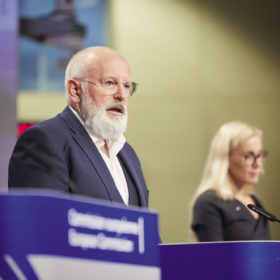
As a business prospect, producing hydrogen via sustainable means remains in its infancy. However, analysts appear increasingly certain that we are seeing the dawn of a vital new industry. In Europe, some countries (such as Germany and Portugal) have already adopted national strategies for the production and use of the fuel. And in July, the European Union also published a comprehensive hydrogen strategy as a central part of a climate-neutral Europe.
From pv magazine 08/2020
Greener methods of producing hydrogen are relatively novel, but of course it is not a new fuel. It can be the product of coal or gas gasification, or steam methane reformation, which usually uses natural gas as the feedstock. Hydrogen is also derived from the breaking of methane into hydrogen and carbon using pyrolysis, and is the product of electrolysis, where the feedstock is water. The idea is to use cheap renewable energy to split water into hydrogen and oxygen via electrolysis, thus generating emission-free hydrogen. The latter is at the core of the new industry that the EU aims to kickstart.
The most apparent use of green hydrogen is to replace what is currently used in a plethora of industrial processes with it. However, when added to natural gas, hydrogen can be a fuel for thermal power or district heat plants. It can also be used to produce synthetic fuels, while a widely touted potential use is to power fuel cells in vehicles and vessels, adding to the decarbonization of the transport sector.
However it is produced and whatever the end use, one thing is certain: The hydrogen industry seeks to pass from old methods and concepts to new ideas. The EU’s newly published hydrogen strategy aims to do exactly this: To establish demand and supply hydrogen markets, facilitate innovation, and lead the industry to maturity via market processes. In fact, the EU is seeking to replicate its renewable energy success, where early policy frameworks and support mechanisms led to innovative efforts and the establishment of an EU-wide renewable energy market that today is widely operating subsidy-free.
Big deal
Central to the development of clean hydrogen is the electrolyzer, the device used for electrolysis. Electrolyzers can range in size from small scale, suited for distributed hydrogen production, to large scale, for deployment in centralized, industrial-scale production facilities.
But electrolyzers are expensive at present. Their cost, said the International Energy Agency last year, could fall by half by 2040 from around $840 per kW of capacity today. Moreover, the efficiency of electrolyzers depends on the amount of electricity used to produce an amount of hydrogen. The efficiency of water electrolyzers ranges today from 60% to 80%, although further innovation and scaling up can lead to higher efficiencies and lower costs.
A widespread idea is that electrolyzers can be tied next to renewable energy plants that feed the electricity network. That way, say proponents of this idea, excess power from solar or wind farms can feed into electrolyzers. Given the high cost of electrolyzers, it remains dubious whether an investor would let their electrolyzers remain dormant until the power grid cannot absorb excess electricity or the price of electricity is very low. It is rather the case that investors will build dedicated renewable energy facilities to power their hydrogen processes.
Another challenge related to hydrogen production is storing and transporting the highly flammable gas to where is needed. Building dedicated pipelines or liquidizing it can add further costs to the value chain.
Gradual trajectory
To enable a hydrogen industry, the EU Commission’s strategy paper argues for a gradual trajectory at different speeds across the various sectors linking to the fuel, and perhaps with different policies applying to the various regions of the bloc.
Thus, the EU roadmap calls for a first phase of hydrogen development between 2020 and 2024, with the objective to install at least 6 GW of renewable hydrogen electrolyzers in the European Union. “In this phase, manufacturing of electrolyzers, including large ones (up to 100 MW), needs to be scaled up,” the commission says. “These electrolyzers could be installed next to existing demand centers in larger refineries, steel plants, and chemical complexes. They would ideally be powered from local renewable electricity sources.” The roadmap’s first phase also calls for new hydrogen end-use applications – most possibly fuel-cell buses and trucks. It becomes apparent though that from an early stage, the Commission’s hydrogen strategy makes for synergies between the renewable energy and the oil and gas sectors.
The second phase, from 2025 to 2030, is when green hydrogen will start to become an intrinsic part of an integrated energy system, aiming to install at least 40 GW of renewable hydrogen electrolyzers. In addition to previous applications, at this point, green hydrogen will increase its use in transport and play an important role in providing daily or seasonal energy storage to balance a renewables-based electricity system.
Finally, in the third phase, from 2030 to 2050, “renewable hydrogen technologies should reach maturity and be deployed at large scale to reach all hard-to-decarbonize sectors,” says the commission. In this phase, a quarter of the EU’s renewable electricity might be used to produce green hydrogen by 2050, with hydrogen-derived synthetic fuels being used in various economic sectors where alternative decarbonization options might not exist or bear higher costs. In the near term, the broad ecosystem of hydrogen stakeholders will need to work together with EU and national institutions to identify a clear pipeline of projects and the right supporting mechanisms that make these projects viable, paving the way to a self-sustained mature market.
Lắp đặt điện mặt trời Khải Minh Tech
https://ift.tt/2X7bF6x
0906633505
info.khaiminhtech@gmail.com
80/39 Trần Quang Diệu, Phường 14, Quận 3
Lắp đặt điện mặt trời Khải Minh Tech
https://ift.tt/2ZH4TRU
Không có nhận xét nào:
Đăng nhận xét